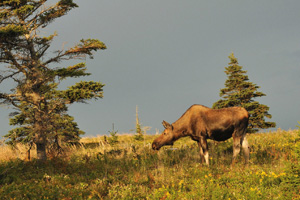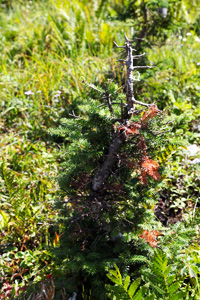Offending Conservation Methodology
"Parks Canada has a proven track record of effective ecosystem management and population reduction is only used in situations where it's absolutely considered necessary."
"We're going to take back all the results [of the reforestation and hunting pilot project], analyze and determine what the best approach might be to restore the boreal forest. Ultimately that's our goal."
"...No decisions have been made past 2018."
Rob Howey, Park conservation manager, Parks Canada
"Cost doesn't seem to be a huge issue as they've already spent close to $1-million killing moose."
"I believe killing an animal in a national park should be a last resort and it seems to me there are other options."
Rose Courage, northern Cape Breton craft shop owner
"From a Mi'qmaq point of view we're out there to provide and we're out there to share."
Clifford Paul, moose management coordinator, Unama'ki Institute of Natural Resources
 |
| A moose forages in the Cape Breton Highlands National Park (Parks Canada) |
Rose Courage was disturbed by what she viewed as two things gone very wrong in Cape Breton Highlands National Park, a forested nature preserve on Nova Scotia's east coast of Canada. First, that animals were being culled as a conservation measure; and second that an inordinate amount of tax dollars was being spent to expedite that cull in remote regions of the park. She felt that all avenues of possible solutions should have been explored and perhaps were not, although she was aware that one of her suggestions, fencing off vulnerable areas to browsing moose, is already being done.
Conservation authorities at Parks Canada had drawn the conclusion that the park was host to too many of the ungulates and their presence was harmful to the forest environment. Their choice menu is the browsing of new tree tips of balsam fir and spruce in the boreal forest, during spring growth, stunting the trees and eventually killing them, holding back forest growth when the purpose of conservation is to encourage the growth of strong and healthy trees.
It had been decided to launch a five-year program for reforestation named "Bring Back The Boreal Forest" which required a hunting component to enable the program to reach its goal. It began with a $1-million budget growing to a budget of $2.1-million. And most of that budget has been allocated to the hunting portion of the two-pronged program. A program which saw the 'harvesting' of 122 animals from a herd estimated in size at 1,800 since 2015. Parks Canada is satisfied with both the cost involved in achieving its goal and the early impressions of its success.
 |
The moose is the largest living deer. It affects the growth of the forest in the park by selectively browsing only certain species of trees. Parks Canada |
Preliminary results from a study carried out in the area demonstrated that twigs of balsam fir and spruce that had attracted moose showed a significant decrease in the number of trees being eaten, deprived of the opportunity to flourish. Roughly half of the twigs were consumed by moose four years ago; this year 90 percent of the new-growth twigs had been untouched, thus increasing the opportunity for the forest to regenerate.
Through access-to-information applications, Rose Courage is anything but impressed by what she had read with regard to the program and resulting research. Where Parks Canada has a total cost for the first three harvests at $731,000, accounting for 122 harvested moose, the costs typically consumed by travel and overtime for park wardens, helicopter flights into remote areas and the charges for airborne moose surveys, Rose Courage adds another $233,000 in policing as well as an additional $7,141 for overtime last fall.
Which brings the average cost related to the removal of every moose to a tad over $7,900. She feels there should be a focus on increasing the use of fenced enclosures to ensure that moose cannot gain access to vulnerable park areas as preferable to the intensive methods of hunting. Parks Canada flies Aboriginal hunters into the park, aids them in removing the carcass, and the food is then distributed to Mi'kmaq communities and food banks throughout Nova Scotia.
 A balsam fir, severely browsed by moose Parks Canada
A balsam fir, severely browsed by moose Parks CanadaLabels: Boreal Forest, Canada, Cape Breton Island, Moose Hunt, Parks Conservation


0 Comments:
Post a Comment
<< Home